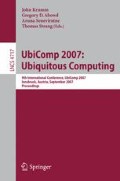Abstract
Hard restrictions in computing power and energy consumption favour symmetric key methods to encrypt the communication in wireless body area networks which in term impose questions on effective and user-friendly unobtrusive ways for key distribution. In this paper, we present a novel approach to establish a secure connection between two devices by shaking them together. Instead of distributing or exchanging a key, the devices independently generate a key from the measured acceleration data by appropriate signal processing methods. Exhaustive practical experiments based on acceleration data gathered from real hardware prototypes have shown that in about 80% of the cases, a common key can be successfully generated. The average entropy of these generated keys exceed 13bits.
Access this chapter
Tax calculation will be finalised at checkout
Purchases are for personal use only
Preview
Unable to display preview. Download preview PDF.
References
Stajano, F.: Security for ubiquitous computing. John Wiley & Sons, Chichester (2002)
Cam, H., Özdemir, S., Muthuavinashiappan, D., Nair, P.: Energy-efficient security protocol for wireless sensor networks. In: IEEE VTC Fall Conference, vol. 5, pp. 2981–2984. IEEE, Los Alamitos (2003)
Bluetooth Spezial Interest Group: Specification of the Bluetooth System. Bluetooth, Version 1.1, vol. 1 (2001)
Bluetooth Spezial Interest Group: Specification of the Bluetooth System. Bluetooth, vol. 2, Version 1.1 (2001)
Muller, T.: Bluetooth security architecture. White Paper Version 1.0, Bluetooth (1999)
Diffie, W., Hellman, M.E.: New directions in cryptography. IEEE Transactions on Information Theory 22, 644–654 (1976)
Raymond, J.F., Stiglic, A.: Security issues in the Diffie-Hellman key agreement protocol. IEEE Transactions on Information Theory 22, 1–17 (2000)
Boyd, C., Mathuria, A.: Key establishment protocols for secure mobile communications: A selective survey. In: Boyd, C., Dawson, E. (eds.) ACISP 1998. LNCS, vol. 1438, pp. 3–540. Springer, Heidelberg (1998)
Bao, L.: Physical activity recognition from acceleration data under semi-naturalistic conditions. Master’s thesis, Massachusetts institute of technology (2003)
Bao, L., Intille, S.S.: Activity recognition from user-annotated acceleration data. In: Ferscha, A., Mattern, F. (eds.) PERVASIVE 2004. LNCS, vol. 3001, pp. 1–17. Springer, Heidelberg (2004)
Hinkley, K.: Bumping objects together as a semantically rich way of forming connections between ubiquitous devices. In: Dey, A.K., Schmidt, A., McCarthy, J.F. (eds.) UbiComp 2003. LNCS, vol. 2864, Springer, Heidelberg (2003)
Lester, J., Hannaford, B., Borriello, G.: “Are you with me?” - Using accelerometers to determine if two devices are carried by the same person. In: Ferscha, A., Mattern, F. (eds.) PERVASIVE 2004. LNCS, vol. 3001, pp. 33–50. Springer, Heidelberg (2004)
Holmquist, L.E., Mattern, F., Schiele, B., Alahuhta, P., Beigl, M., Gellersen, H.W.: Smart-its friends: A technique for users to easily establish connections between smart artefacts. In: Abowd, G.D., Brumitt, B., Shafer, S. (eds.) Ubicomp 2001: Ubiquitous Computing. LNCS, vol. 2201, pp. 273–291. Springer, Heidelberg (2001)
Mayrhofer, R., Gellersen, H.: Shake well before use: Authentication based on acceleration data. In: Pervasive 2007: 5th International Conference on Pervasive Computing. LNCS, vol. 4480, pp. 144–161. Springer, Heidelberg (2007)
Huynh, T., Schiele, B.: Analyzing features for activity recognition. In: SocEUSAI, vol. 121, pp. 159–163 (2005)
Aylward, R., Lovell, S.D., Paradiso, J.A.: A compact, wireless, wearable sensor network for interactive dance ensembles. In: Proceedings of the International Workshop on Wearable and Implantable Body Sensor Networks (BSN 2006), vol. 00, pp. 65–70. IEEE Computer Society Press, Los Alamitos (2006)
Shannon, C.: A mathematical theory of communication. Bell System Technical Journal 27, 379–423, 623–656 (1948)
Weigend, A.S., Gershenfeld, N.A.: Time series prediction: Forecasting the future and understanding the past, vol. 15. Addison-Wesley Publishing Company (1994)
Molgedey, L., Ebeling, W.: Local order, entropy and predictability of financial time series. In: The European Physical Journal B - Condensed Matter and Complex Systems, vol. 15, pp. 733–737. Springer, Heidelberg (2004)
Proakis, J.G., Manolakis, D.G.: Digital Signal Processing: Principles, Algorithms, and Applications, 2nd edn. Macmillan Publishing Company (1992) ISBN 0-02-396815-X
Haykin, S.: Adaptive filter theory, 4th edn. Prentice-Hall, Englewood Cliffs (2002)
Patterson, D.: Artificial neural networks, theroy and applications. Prentice Hall Inc., Englewood Cliffs (1996)
Author information
Authors and Affiliations
Editor information
Rights and permissions
Copyright information
© 2007 Springer-Verlag Berlin Heidelberg
About this paper
Cite this paper
Bichler, D., Stromberg, G., Huemer, M., Löw, M. (2007). Key Generation Based on Acceleration Data of Shaking Processes. In: Krumm, J., Abowd, G.D., Seneviratne, A., Strang, T. (eds) UbiComp 2007: Ubiquitous Computing. UbiComp 2007. Lecture Notes in Computer Science, vol 4717. Springer, Berlin, Heidelberg. https://doi.org/10.1007/978-3-540-74853-3_18
Download citation
DOI: https://doi.org/10.1007/978-3-540-74853-3_18
Publisher Name: Springer, Berlin, Heidelberg
Print ISBN: 978-3-540-74852-6
Online ISBN: 978-3-540-74853-3
eBook Packages: Computer ScienceComputer Science (R0)

